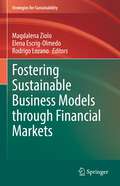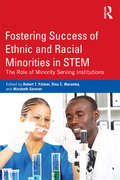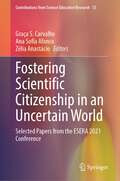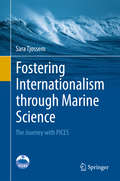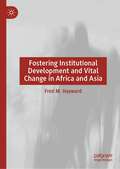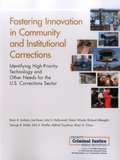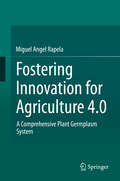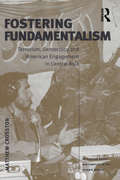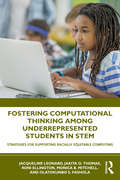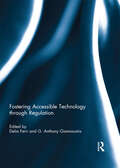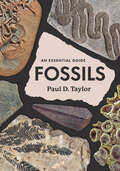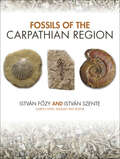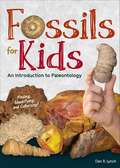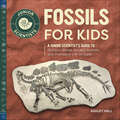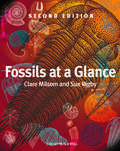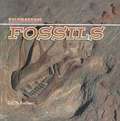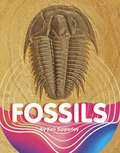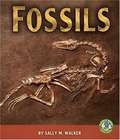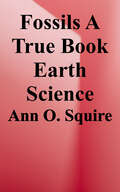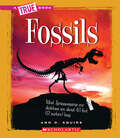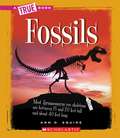- Table View
- List View
Fostering Sustainable Business Models through Financial Markets (Strategies for Sustainability)
by Magdalena Ziolo Rodrigo Lozano Elena Escrig-OlmedoThe aim of this volume is to foster more sustainable business models through financial markets. To that end, it is necessary to know the main global challenges facing financial markets and their impact on creating sustainable value in business models of enterprises in the context of sustainable adaptation. The book focuses on assessing the decision criteria adopted by financial markets in the process of transaction risk valuation, in terms of the presence of Environmental, Social, and Governance (ESG) criteria, and by assessing the impact of including these criteria in the risk assessment process by financial markets in business decisions, leading as a consequence to building new value in the form of a sustainable business model. The book presents global ESG risks facing the financial markets, and discusses how ESG risks are managed and monitored, and how financial markets can measure and operationalize extra-financial risks in its assessment process. The book also analyses ESG risk implications and influences on company behavior, and the actions that companies should take considering the ESG assessment requirements of financial markets. Finally, it provides a comprehensive, structured, and systematic view of how financial markets and companies should adapt and improve their business models. The book provides unique challenges for investors, companies, financial markets, and for our society as a whole, advancing traditional risk management approaches to address global risks.
Fostering Success of Ethnic and Racial Minorities in STEM: The Role of Minority Serving Institutions
by Dina C. Maramba Marybeth Gasman Robert T. PalmerTo maintain competitiveness in the global economy, United States policymakers and national leaders are increasing their attention to producing workers skilled in science, technology, engineering, and mathematics (STEM). Given the growing minority population in the country, it is critical that higher education policies, pedagogies, climates, and initiatives are effective in promoting racial and ethnic minority students’ educational attainment in STEM. Minority Serving Institutions (MSIs) have shown efficacy in facilitating the success of racial and ethnic minority students in STEM and are collectively responsible for producing nearly one-third of the nation’s minority STEM graduates. In Fostering Success of Ethnic and Racial Minorities in STEM, well-known contributors share salient institutional characteristics, unique aspects of climate, pedagogy, and programmatic initiatives at MSIs that are instrumental in enhancing the success of racial and ethnic minority students in STEM education. This book provides recommendations on institutional practice, policy, and lessons that any institution can use on their campus to foster better retention and persistence among minority students. Higher Education leaders and administrators interested in encouraging achievement among racial and ethnic minority students in STEM education will find this book a welcomed and timely addition to the discourse on promoting minority student success.
Fostering Scientific Citizenship in an Uncertain World: Selected Papers from the ESERA 2021 Conference (Contributions from Science Education Research #13)
by Graça S. Carvalho Ana Sofia Afonso Zélia AnastácioThis edited volume brings together innovative research in the field of Science Education, fostering scientific citizenship in an uncertain world. The nineteen chapters presented in this book address diverse topics, and research approaches carried out in various contexts and settings worldwide, contributing to improving and updating knowledge on science education. The book consists of selected high-quality studies presented at the 14th European Science Education Research Association (ESERA) Conference, held online (due to the Covid-19 pandemic) by the University of Minho, Portugal, between August 30th and September 3rd, 2021. Being of great relevance in contemporary science education, this book stimulates reflection on different approaches to enhance a deeper understanding of how better prepare the coming generations, which is of great interest to science education researchers and science teachers.
Fostering Internationalism through Marine Science
by Sara TjossemThis book describes the work of the North Pacific Marine Science Organization (PICES) since its launch 1992. Mapping the evolution of its agenda gives insight into the development of modern marine science in the context of competing demands of stakeholders within and outside the organization. The opening chapter consider the challenges of marine science as a large scale, and places PICES in the contexts of internationalism and science-based resource management. They also lay out the organization's longstanding focus on the development of climate science and its applications. Subsequent chapters explore the pros and cons of national vs. international science, negotiating the nature of investigation and cooperation across scientific, political and institutional boundaries in the region; national perspectives on purpose, scope, and mandates; assessing two major initiatives undertaken to date; the challenges of incorporating social science into an organization of mainly natural scientists.
Fostering Institutional Development and Vital Change in Africa and Asia
by Fred M. HaywardThis book looks at the question of what makes for successful change in developing countries. It focuses on people at every level in six developing countries in Africa and Asia who have helped foster positive change and development, most of which has been successful. Here, in contrast to so much academic writing on development which focuses on leadership alone, the author tries to get beyond that elite focus and highlight the people at all levels who make change possible. He examines the role and significance of these ordinary citizens and groups as well as leaders. Transformation almost always requires action and support at multiple levels from individuals, communities, and local leaders. The project analyses the cases of Afghanistan, Madagascar, Sierra Leone, Ghana, Pakistan, and South Africa.
Fostering Innovation in Community and Institutional Corrections: Identifying High-Priority Technology and Other Needs for the U.S. Corrections Sector
by Richard Silberglitt Brian A. Jackson Brian G. Chow John S. Hollywood Dulani Woods Joe Russo George B. Drake John S. Shaffer Mikhail ZaydmanGiven the challenges posed to the U. S. corrections sector, such as tightened budgets and increasingly complex populations under its charge, it is valuable to identify opportunities where changes in tools, practices, or approaches could improve performance. In this report, RAND researchers, with the help of a practitioner Corrections Advisory Panel, seek to map out an innovation agenda for the sector.
Fostering Innovation for Agriculture 4.0: A Comprehensive Plant Germplasm System
by Miguel Angel RapelaThe scientific and technical development of any kind of germplasm is regulated by a vast network of treaties, conventions, international agreements, and national and regional legislation. These regulations govern biotechnological innovations in plants and microorganisms, access to and use of plant genetic resources, and biosafety. This complex mix has made it difficult to arrive at global interpretations, due to overlaps, gaps, ambiguities, contradictions, and lack of consistency. The big picture is even more complex, as a series of scientific developments – gene editing in particular – have in some cases rendered these international regulatory frameworks obsolete.This book puts forward an innovative approach: a “Comprehensive Plant Germplasm System”. The System is a cooperative game theory-based proposal for a binding international convention which would supersede all other conventions, treaties, national and regional legislation covering native varieties and traditional developments, heterogeneous plant varieties, microorganisms, biotechnological inventions, plant genetic resources, and biosafety regulation. In short, it offers a comprehensive framework regarding intellectual property, biosafety, and business regulation and covers all types of germplasm.If applied, the system is expected to yield higher productivity rates in crops and improved food biodiversity, as well as a new paradigm based on the promotion of innovation for “Agriculture 4.0.”
Fostering Fundamentalism: Terrorism, Democracy and American Engagement in Central Asia (US Foreign Policy and Conflict in the Islamic World)
by Matthew CrosstonIs the United States, in its fight against terror and pursuit of Osama Bin Laden, recklessly creating conditions in Central Asia to produce the next Bin Laden? Matthew Crosston studies this controversial argument in his political analysis of US foreign policy on Central Asia. He looks specifically at the 'no-man's land nexus' connecting Tajikistan, Uzbekistan and Kyrgyzstan and the heart of Central Asian Islamic radicalism - the Fergana Valley. This book breaks new ground by examining in unflinching detail the unwitting role US foreign policy plays in fomenting that 'hot zone' and extremism, producing a new generation of Islamic radicals. University courses that deal with US foreign policy, international security, terrorism and/or Eurasian politics will want to make this book required reading.
Fostering Computational Thinking Among Underrepresented Students in STEM: Strategies for Supporting Racially Equitable Computing
by Olatokunbo S. Fashola Jacqueline Leonard Jakita O. Thomas Roni Ellington Monica B. MitchellThis book broadly educates preservice teachers and scholars about current research on computational thinking (CT). More specifically, attention is given to computational algorithmic thinking (CAT), particularly among underrepresented K–12 student groups in STEM education. Computational algorithmic thinking (CAT)—a precursor to CT—is explored in this text as the ability to design, implement, and evaluate the application of algorithms to solve a variety of problems. Drawing on observations from research studies that focused on innovative STEM programs, including underrepresented students in rural, suburban, and urban contexts, the authors reflect on project-based learning experiences, pedagogy, and evaluation that are conducive to developing advanced computational thinking, specifically among diverse student populations. This practical text includes vignettes and visual examples to illustrate how coding, computer modeling, robotics, and drones may be used to promote CT and CAT among students in diverse classrooms.
Fostering Accessible Technology through Regulation
by Delia Ferri and G. Anthony GiannoumisTechnology has attracted an increasing level of attention within studies of disability and disability rights. Many researchers and advocates have maintained skepticism towards technology out of the fear that technology becomes another way to ‘fix’ impairments. These skeptical views, however, contrast with a more positive approach towards the role that technology can play in eliminating barriers to social participation. Legal scholarship has started to focus on accessibility and accessible technology and in conjunction with the recently adopted United Nations Convention on the Rights of Persons with Disabilities has put a great emphasis on accessibility, highlighting the role that accessible technology plays in the promotion and protection of the rights of people with disabilities. Against this background, this book gathers together different contributions that focus on enhancing the production, marketing and use of accessible technology. Building upon previous academic studies and in light of the UNCRPD, accessible technology is considered a tool to increase autonomy and participation. Overall, this book attempts to show, through a multifaceted and inter-disciplinary analysis, that different regulatory approaches might enhance accessible technology and its availability. This title was previously published as a special issue of the International Review of Law, Computers & Technology.
Fossils: The Key to the Past
by Richard A. ForteyA guide for amateur fossil collectors and general readers to how fossils came about, how to find and identify them, and their economic and practical importance. Emphasizes fossils easy to find. Includes a short glossary without pronunciation.
Fossils: An Essential Guide
by Paul D. TaylorWith stunning images and an expert guide, explore the world of fossils to uncover the story of life on Earth, from the origins of new life to mass extinctions. Ancient Earth seems like an alien world. But the fossil record can help reveal the mysteries of the organisms that have lived on our planet since its formation some 4,600 million years ago. In this engaging and beautifully illustrated book, world-renowned paleontologist Paul D. Taylor provides a comprehensive guide to all aspects of fossils to tell the story of life on Earth. Taylor begins with the basics: how fossils form, how they mark geological time, and what they tell us about the origins of life and major evolutionary events like the Cambrian Explosion. He then shows the oldest fossils—single-celled bacteria in amazing, three-billion-year-old microbial rock structures—before introducing the first animals in the fossil record. From fishes to amphibians, reptiles, and mammals, we meet these animal fossils in an appropriate evolutionary parade. Next, we imagine plants long past, charting the evolution of this kingdom and learning how ephemeral botanical remains can become permanent records. While comprehensive in his coverage of fossil groups and ages, Taylor pays particular attention to specimens fossil hunters are most likely to encounter, like crinoids and the iconic ammonites. Throughout, he introduces us to fascinating fossil folklore—like the idea that ammonites are the petrified remains of coiled snakes—and helps us distinguish true fossils from fakes. With stunning color images of many original specimens from the collections of London’s Natural History Museum, Fossils is an essential introduction, connecting life on Earth today to the ancient past.
Fossils of the Carpathian Region (Life of the Past)
by István Szente István FozyA comprehensive review of the fossil record of the Carpathian Basin.Fossils of the Carpathian Region describes and illustrates the region’s fossils, recounts their history, and tells the stories of key people involved in paleontological research in the area. In addition to covering all the important fossils of this region, special attention is given to rare finds and complete skeletons. The region’s fossils range from tiny foraminifera to the Transylvanian dinosaurs and mammals of the Carpathian Basin. The book also gives nonspecialists the opportunity to gain a basic understanding of paleontology. Sidebars present brief biographies of important figures and explain how to collect, prepare, and interpret fossils.“An excellently written scientific book. . . . The good illustrations are an incentive to start reading and dive into the wide area covered by two experts in their respective fields. . . . A rich source of otherwise not published background knowledge on the paleontology and geology of the region.” —Christian A. Meyer, Natural History Museum, Basel“Fossils of the Carpathian Region . . . is beautifully produced with high-quality color illustrations throughout and an exhaustive bibliography and index. . . . Highly recommended.” —Choice“This book fills a gap in the geological texts on the Carpathians, especially in Hungary, and offers a valuable wealth of geological-paleontological and scientific-historical information from the Ordovician to the Pleistocene. This extensive and relatively inexpensive work is an unrivaled recommendation for amateurs and amateur geologists / paleontologists.” —Zentralblatt für Geologie und Paläontologie [translated from German]
Fossils for Kids: An Introduction to Paleontology
by Dan R. LynchAs incredible as it sounds, fossils are all around us, waiting to be discovered. Become a young paleontologist. Learn all about ancient lifeforms preserved in rock. Dan R. Lynch, author of many Rocks & Minerals field guides, presents a kids’ introduction to fossils. Begin by learning about the early Earth and the process of fossilization. That’s followed by an identification guide to the most common and collectible fossils: crinoids, snail shells, shark teeth, and more. With full-color photographs and illustrations, you’ll always know what to look for. A “how to” section includes the details your family needs to begin a successful fossil hunt. You’ll also get information on everything from rock shop fossils and rules of collecting to dinosaur fossils and more. So learn to find, identify, and even collect the petrified forms of ancient organisms. Whether children see their first fossil at a museum or find their own fossil seashells, this easy-to-understand book is a perfect guide for beginners.
Fossils for Kids: A Junior Scientist's Guide to Dinosaur Bones, Ancient Animals, and Prehistoric Life on Earth (Junior Scientists)
by Ashley HallUncover the ancient past—a guide to fantastic fossils for kids ages 6 to 8Set off on an amazing adventure into the prehistoric past when dinosaurs roamed the Earth. Fossils for Kids is filled with fascinating photographs and captivating facts that will teach junior fossil hunters how fossils form, where they are found, and tips on how to identify them.Start by learning more about some of your favorite dinosaurs—from Velociraptor to Tyrannosaurus rex—and where you can see the coolest dinosaur skeletons. Then discover the creatures that predate even the dinosaurs! You'll meet famous birds, like the Archaeopteryx, explore tiny invertebrate trilobites, and learn which ancient plant is the source of a delicious drink—root beer!Fossils for Kids includes:Beyond dinos—You won't just be learning about dinosaurs; this book covers mammals, other reptiles, and plant fossils.Greater knowledge—Use the fun sidebars to dive deeper into the fossil world and get more hands-on learning.Clear images—The colorful pictures allow you to easily identify fossils.It's time to unearth your scientific curiosity—there's no telling what you'll find using Fossils for Kids as your guide.
Fossils at a Glance
by Sue Rigby Clare MilsomFossils provide a powerful tool for the study of the nearly 4-billion-year history of life, and its role in the evolution of Earth systems. They also provide important data for evolutionary studies, and contribute to our understanding of the extinction of organisms and the origins of modern biodiversity. Fossils At A Glance is written for students taking an introductory level course in paleontology. Short chapters introduce the main topics in the modern study of fossils. The most important fossil groups are discussed, from microfossils through invertebrates to vertebrates and plants, followed by a brief narrative of life on Earth. Diagrams are central to the book and allow the reader to see most of the important data “at a glance”. Each topic covers two pages and provides a self-contained suite of information or a starting point for future study. This second edition has been thoroughly revised and brought up to date. It includes new line diagrams as well as photographs of selected fossils
Fossils Tell of Long Ago (Let's-Read-and-Find-Out Science 2)
by AlikiWhat is a fossil?Sometimes it's the imprint of an ancient leaf in a rock. Sometimes it's a woolly mammoth, frozen for thousands of years in the icy ground. Sometimes it's the skeleton of a stegosaurus that has turned to stone.A fossil is anything that has been preserved, one way or another, that tells about life on Earth. But you can make a fossil, too—something to be discovered a million years from now—and this book will tell you how.
Fossils (Rocks and Minerals)
by Melissa StewartHave you ever wondered how fossils are formed, or why so many fossils are found in tar pits? Do you know what a coprolite is? How do scientists determine a fossil's age? Read Fossils to find the answers to these questions and many more. You'll also find a hands-on activity to try at home or at school, as well as a glossary of unfamiliar words, resources to help you locate additional information, and a useful index.
Fossils (Kaleidoscope)
by Roy A. GallantDescribes what fossils are, how they are formed, and what they tell scientists about earth's past.
Fossils (Earth Materials and Systems)
by Keli SipperleyPlants and animals from millions of years ago left behind fossils. Fossils can teach people about the past. They are also used for fuel. Discover why fossils are an important part of nature!
Fossils (Early Bird Earth Science)
by Sally M. WalkerFossils are the hardened remains of plants and animals. Remains are parts left behind after plants or animals die. All fossils are old. Fossils are the traces and remains of plants and animals that lived more than 10,000 years ago.
Fossils (A True Book (relaunch): Earth Science Series)
by Ann O. SquireFossils are one of the most important tools we have for learning about long-extinct wildlife. A True Book: Earth Science series presents fascinating facts and fun activities that will engage the budding earth scientist, while exploring the fields of geology, meteorology, ecology, and more. <p><p>This series includes an age appropriate (grades 3-5) introduction to curriculum-relevant subjects and a robust resource section that encourages independent study. In the 4.6 billion years since Earth was formed, many plant and animal species have come and gone. Readers will discover how fossils are formed, how paleontologists search for them, and what kinds of information they can provide.
Fossils (A True Book (Relaunch))
by Ann O. SquireFossils are one of the most important tools we have for learning about long-extinct wildlife.A True Book: Earth Science series presents fascinating facts and fun activities that will engage the budding earth scientist, while exploring the fields of geology, meteorology, ecology, and more. This series includes an age appropriate (grades 3-5) introduction to curriculum-relevant subjects and a robust resource section that encourages independent study.In the 4.6 billion years since Earth was formed, many plant and animal species have come and gone. Readers will discover how fossils are formed, how paleontologists search for them, and what kinds of information they can provide.
Fossils
by Ann O. SquireDid you ever wonder how scientists have learned so much about Earth's history? How do we know what the dinosaurs looked like, what they ate, or where they lived? How do we know that fish existed before mammals? How have we learned about our human ancestors? <p><p>The answer to these questions is through the study of fossils. Fossils are the remains, or traces, of animals and plants that have been preserved in the earth's rocky crust.
